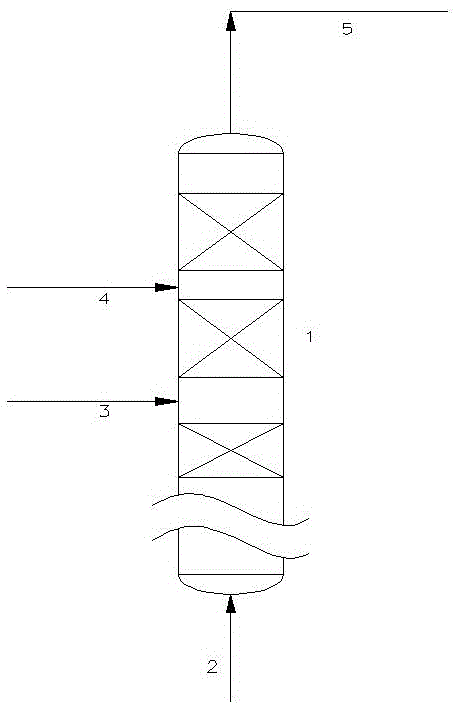A hydrogenation process for producing hydrogen peroxide by anthraquinone method
An anthraquinone method, hydrogen peroxide technology, applied in the directions of peroxide/peroxyhydrate/peroxyacid/superoxide/ozone, inorganic chemistry, chemical instruments and methods, etc., to reduce production costs and improve selectivity , the effect of improving the quality level
- Summary
- Abstract
- Description
- Claims
- Application Information
AI Technical Summary
Problems solved by technology
Method used
Image
Examples
Embodiment 1
[0029] The hydrogenation reactor is filled with three stages of catalysts, from top to bottom are the catalyst beds I, II and III. The hydrogen is divided into three streams of hydrogen I, II and III and introduced into the reactor respectively. The hydrogenation temperature is 42°C and the hydrogenation pressure is 0.23 MPa. First all working liquid and hydrogen I flow into the reactor from the top of the reactor concurrently, hydrogenation reaction occurs in catalyst bed I, and the volume flow rate of hydrogen I and total hydrogen (Nm 3 / h) ratio is 1:3.78, the residence time of the material in the catalyst bed I is 3.05 minutes; the volume flow rate of hydrogen II and total hydrogen (Nm 3 / h) ratio is 1:1.97, the material residence time of the material in the catalyst bed II is 1.64 minutes; the volume ratio of the hydrogen III introduced by the catalyst bed III to the total hydrogen is 1:4.96, the material in the catalyst bed III The residence time was 1.5 minutes. After...
Embodiment 2
[0031] The hydrogenation reactor is filled with three stages of catalysts, which are catalyst beds I, II and III from top to bottom. The working liquid is divided into two streams of working liquid I and II, and the hydrogen is divided into three streams of hydrogen gas I, II and III to be introduced into the reaction. device, the hydrogenation temperature is 45°C, and the hydrogenation pressure is 0.25Mpa. The working liquid I and the hydrogen gas I flow into the reactor from the top of the reactor concurrently, and a hydrogenation reaction occurs on the catalyst bed I. Volume flow of working fluid I and total working fluid (m 3 / h) ratio is 1:1.24, the volume flow rate of hydrogen I to total hydrogen (m 3 / h) ratio is 1:2.8, the material residence time in catalyst bed I is 2.25 minutes; the volume flow rate of working fluid II and total working fluid (m 3 / h) ratio is 1:5.21, the volume flow rate of hydrogen and total hydrogen in catalyst bed II (m 3 / h) ratio is 1:2.69, t...
Embodiment 3
[0033] The hydrogenation reactor is filled with four stages of catalysts, which are catalyst beds I, II, III and IV from top to bottom. The working liquid is divided into three streams of working liquid I, II and III, and the hydrogen is divided into hydrogen I, II and III. The four strands and IV are introduced into the reactor, the hydrogenation temperature is 43°C, and the hydrogenation pressure is 0.2Mpa. The working liquid I and the hydrogen gas I flow into the reactor from the top of the reaction side by side, and the hydrogenation reaction occurs in the catalyst bed I. Volume flow of working fluid I and total working fluid (m 3 / h) ratio is 1:1.84, the volume flow rate of hydrogen I to total hydrogen (Nm 3 / h) ratio is 1:4.66, the material residence time in catalyst bed I is 1.94 minutes; the volume flow rate of working fluid II and total working fluid (m 3 / h) ratio is 1:4.38, the volume flow rate of hydrogen II to total hydrogen (Nm 3 / h) ratio is 1:5.7, the materi...
PUM
| Property | Measurement | Unit |
|---|---|---|
| crushing resistance | aaaaa | aaaaa |
Abstract
Description
Claims
Application Information
 Login to View More
Login to View More - R&D
- Intellectual Property
- Life Sciences
- Materials
- Tech Scout
- Unparalleled Data Quality
- Higher Quality Content
- 60% Fewer Hallucinations
Browse by: Latest US Patents, China's latest patents, Technical Efficacy Thesaurus, Application Domain, Technology Topic, Popular Technical Reports.
© 2025 PatSnap. All rights reserved.Legal|Privacy policy|Modern Slavery Act Transparency Statement|Sitemap|About US| Contact US: help@patsnap.com


